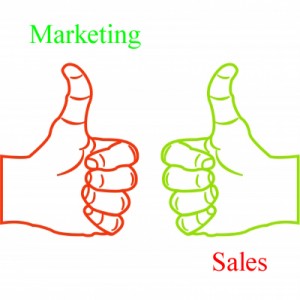MARKETING vs SALES – LET BATTLE CONCLUDE!

As we move through January I thought I would think backwards rather than forwards, reflecting on one area of business that seems to have remained forever constant. The area? The relationship between sales and marketing – I can remember how difficult it was in the 1980s and 90s. In 2006, Philip Kotler, well known academic from the United States produced an interesting paper on the subject in Harvard Business Review. But ten years later has much changed? No. Whenever I speak to marketing people about sales they are somewhat dismissive. When I speak to sales managers about marketing they just roll their eyes.
WHAT GOOGLE TELLS US

So I decided to do some Google searches. When I typed in “What’s the difference between sales and marketing” there were 211 million possible answers. This reduced somewhat when I asked the following questions “Why do sales people hate/dislike marketing people?”, “Why do marketing people hate/dislike sales people?” Now there are between half and three quarters of a million possible answers – hardly insignificant!
So why does this deep divide exist?
WHAT THEY SAY ABOUT EACH OTHER
When you speak to marketing people, they tend to talk about sales people in the following terms:
- Their research is anecdotal not scientific
- They don’t really add to the meaning of the brand and in fact rarely get the meaning of the brand
- They don’t buy into the marketing plan – they just sell
- Whilst they are sales driven (naturally!) they don’t quite understand from where these sales actually originate
Quite possibly some of these opinions come from that famous Peter Drucker quote “the aim of marketing is to make selling superfluous”. If you are taught this at “marketing school” it is bound to impact on your thinking.
So what do sales people think of marketers?
- They dislike their brand plans and presentational guidelines – what’s the point?
- They are sceptical about marketing’s input in pricing, claiming in many cases prices are simply too high
- They’re very concerned about the amount of “promotional” budget that goes to those brand building strategies so beloved by marketers – why not put the budget into direct sales?
- Above all they wonder whether marketing people have ever actually met a customer!
In Philip Kotler’s interesting paper, he talked about the evolution of marketing departments. Small companies are likely to have no formal marketing function but will have sales people. Ideas about market development are generated collaboratively. As the company grows then a marketing assistant, usually called a marketing manager, will be appointed with the role of supporting the sales force through website and collateral activity. As the company further grows and matures, so the marketing function expands into more specialist areas such as segmentation, insight, sentiment, brand and, of course, a more holistic marketing mix. Suddenly the sales function is not quite so important and an internal rival is now doing more than sales support – and demanding more budget as well! And so the marketing vs sales folklore starts.
SO WHAT’S TO BE DONE?
Well we could just let everything roll on and I’ll write another blog on the subject in 2026! Or we can start to take a more holistic and dare I say, grown up approach, to the management of this issue. So here are my five key points to promote peace (and prosperity) in your business:
1. It’s the customer that counts
Let’s get back to basics. The role of any organisation is to gain, satisfy and keep the customer. It’s neither purely sales’ or marketing’s responsibility – but they can both play a major role. Real customer focus is not territorial. Marketing and sales typically focus on different parts of the sales funnel but what they need to focus on is one customer journey.
2. Joint mapping of customer journey
Marketing and sales need to work together to map the customer journey. As key contacts of the customer, they can map out every part of the customer journey and exert real influence on post sales activity – the actual delivery of the product or service. It’s not just price or message – it’s product and delivery which get customers to come back.
3. Accountability and joint accountability
In very few organisations do marketing and sales have meaningful accountability for actual customer experience. I never cease to be surprised by the number of companies, especially in retail, whose customer responsibility is via the “trading” function. Even the name seems wrong to me and it signifies a very different relationship with customers. Yet it’s marketing and sales who introduce customers to that experience and this can result in customers either feeling they’ve been sold the right promise, or the wrong one. But by that time it’s someone else’s responsibility. So let’s move beyond metrics which purely focus on “profile” and “quarterly sales” to those which include “satisfied” and “repeat” customers and include marketing and sales in accountability.
4. Joint research
Who is responsible for marketing research? Often marketing. Rarely sales. Frequently the research department! Let’s develop a joint marketing and sales approach to marketing research so that the two together are driving the agenda and the insights link to the new accountability.
5. Sharing of seniority
Senior marketing people should be involved in sales policy development and vice versa. My recommendations above won’t count for anything should the marketing and sales directors not lead from the front. And this is no easy direction. Years of conflict to years of co-operation – not easy.
SO WHERE DOES THIS TAKE US?
Hopefully a change in organisational culture (working together) which leads to a far more productive change in activity (joint responsibility for customer journey). If both areas work together then perhaps we can include the full Peter Drucker quote “the aim is to know and understand the customer so well that the product or service fits him/her and sells itself”.
Marketing and sales need to work together to become the company’s customer representatives. Together, rather than apart, they can have a strategic influence on the actual development of the products and services that come into the market. This might lead to a timely change in board structure. Research shows us that less than 10% of FTSE 100 companies actually have such a representative, spending far more time talking about cash flow than customer. Surely this can’t be right? But maybe it’s the result of two directors taking different customer responsibilities – division leads to less influence.
So, what’s your experience. What do you think? And could we see a time when the term “Customer” replaces “Marketing” and “Sales”?

